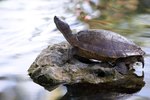
False map turtles are aquatic turtles native to the Mississippi and Missouri river drainage basins. In the wild, you might glimpse them basking on rocks or logs for a brief moment before they notice you and plop into the water. False map turtles aren’t the ubiquitous pets that red-eared sliders are, but they can make suitable captives as long as their keeper provides for their needs.
Habitat
False map turtles (Graptemys pseudogeographica) are typically found in large rivers, though they occasionally inhabit oxbows and backwaters that are in close proximity to a main river channel. False map turtles are excellent swimmers who prefer deep water. Given this, captive map turtles need spacious accommodations; a single animal requires at least 6 to 8 square feet of space, and a pair need at least 8 square feet. House a pair in an aquarium, a stock tank or a prefabricated pond liner. In areas with appropriate temperatures, false map turtles inhabit outdoor ponds, which give captives more space and exposure to natural sunlight.
Water Quality
Water quality is important for turtles, particularly for map turtles. Turtles degrade the quality of water much more quickly than a group of fish kept in a common tank would. Significant filtration is necessary. As a rule of thumb, use a filter rated at triple the capacity of the amount of water in the aquarium or stock tank. In a turtle habitat, the aquarium or tank is not usually filled to capacity -- a 100-gallon stock tank likely has 50 to 75 gallons of water in it, which necessitates a filter designed for 150 to 225 gallons. Canister-style filters are most appropriate for tanks of this size, though the style isn’t as important as the capacity is. Even with quality filtration, weekly partial water changes are a good maintenance practice.
Basking Behavior
Wild false map turtles bask frequently to maintain proper body temperatures and absorb UVB rays from the sun in order to use their dietary calcium. In captivity, these turtles require a heat lamp and UVB-light suspended over a portion of the habitat. Under such lighting, the turtles should have access to a branch or pile of rocks that allow the turtle to completely leave the water. The basking temperature should be about 90 degrees Fahrenheit. The remainder of the aquarium needs good lighting, but expensive UVB-producing bulbs aren't necessary. All of the lights should be routed through a timer set to an interval of 12 hours a day.
Feeding
False map turtles are considerably more carnivorous than other freshwater turtles like red-eared sliders and painted turtles (Chrysemys picta). Both genders heavily predate aquatic insects, fish carrion and algae; however, the larger females are able to add mollusks and crayfish to their diet. In captivity, false map turtles should eat a varied diet that includes insects, fish and commercial turtle pellets. False map turtles are prone to becoming obese in captivity, so adults should eat two to three times per week. Young turtles who are still growing quickly can subsist satisfactorily on an every-other-day schedule. Periodically, use a vitamin and mineral supplement on the food, especially for growing turtles or breeding females.
Growth
False map turtles exhibit extreme sexual dimorphism; males reach about 5 inches in length, but females attain almost double that length. This is a common trend among animals with noncombative males -- rather than fight over females; male false map turtles seem indifferent to each other while clamoring for the acceptance of a female. Males attain adult size faster than females do, achieving maturity in five or six years. Females require a decade or longer to reach maturity.
References
Photo Credits
-
John Foxx/Stockbyte/Getty Images




